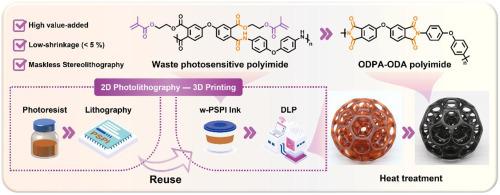当前位置:
X-MOL 学术
›
Chem. Eng. J.
›
论文详情
Our official English website, www.x-mol.net, welcomes your feedback! (Note: you will need to create a separate account there.)
High value-added use of waste photosensitive polyimide to develop low-shrinkage UV-curable inks for digital light projection technology
Chemical Engineering Journal ( IF 13.3 ) Pub Date : 2024-06-28 , DOI: 10.1016/j.cej.2024.153594 Jiachen Wan , Songyang Zhang , Yunhao Wei , Jianan Yuan , Qinghua Lu
Chemical Engineering Journal ( IF 13.3 ) Pub Date : 2024-06-28 , DOI: 10.1016/j.cej.2024.153594 Jiachen Wan , Songyang Zhang , Yunhao Wei , Jianan Yuan , Qinghua Lu

|
In the mass industrial production process of polyimide photoresists, waste generation is inevitable due to unqualified molecular weights, inappropriate ionic content of resins, or storage expiration. Consequently, the recycling and reuse of waste photosensitive polyimide (w-PSPI) is a growing concern in both scientific and industrial communities. In this work, w-PSPI was explored to prepare photocurable, fully crosslinked inks for digital light projection technology (DLP). For this purpose, suitable photoactive solvents and crosslinking agents were first screened to overcome the issue of large shrinkage caused by solvent volatilization. The formation of cross-linked network structures during DLP processing and subsequent imidization was also investigated. As a result, a polyimide DLP ink with minimum size shrinkage (less than 5 %) was proposed. For a given active solvent, the mechanical behavior and heat resistance of DLP-formed objects were significantly influenced by the ratio of short-chain and long-chain crosslinkers and the imidization temperature. By optimizing ink composition and imidization temperature, the DLP-formed objects showed high heat resistance ( > 385 °C, > 150 °C) and balanced mechanical properties of strength and toughness (Modulus ≥1 GPa, elongation at break >5 %). This w-PSPI ink has been successfully utilized to manufacture several complex 3D structures and vertical 3D microarrays with 100-µm on a limited-resolution DLP printer. This study not only points the direction for the high-added utilization of w-PSPI but also demonstrates the potential for expanding PSPI application from 2D lithography to 3D micro-manufacturing.
中文翻译:

高附加值利用废旧感光聚酰亚胺开发低收缩UV固化油墨用于数字光投影技术
在聚酰亚胺光刻胶的大规模工业生产过程中,由于分子量不合格、树脂离子含量不合适或储存过期而产生废物是不可避免的。因此,废弃光敏聚酰亚胺(w-PSPI)的回收和再利用日益受到科学界和工业界的关注。在这项工作中,我们探索了 w-PSPI 来制备用于数字光投影技术 (DLP) 的光固化、完全交联油墨。为此,首先筛选合适的光敏溶剂和交联剂,以克服溶剂挥发引起的大收缩问题。还研究了 DLP 处理和随后的亚胺化过程中交联网络结构的形成。因此,提出了一种具有最小尺寸收缩(小于 5%)的聚酰亚胺 DLP 油墨。对于给定的活性溶剂,DLP 形成的物体的机械性能和耐热性受到短链和长链交联剂的比例以及酰亚胺化温度的显着影响。通过优化油墨成分和酰亚胺化温度,DLP形成的物体表现出高耐热性(> 385 °C,> 150 °C)以及强度和韧性平衡的机械性能(模量≥1 GPa,断裂伸长率> 5%)。这种 w-PSPI 墨水已成功用于在有限分辨率 DLP 打印机上制造多种复杂的 3D 结构和 100 µm 的垂直 3D 微阵列。这项研究不仅为w-PSPI的高附加值利用指明了方向,而且展示了PSPI应用从2D光刻扩展到3D微制造的潜力。
更新日期:2024-06-28
中文翻译:

高附加值利用废旧感光聚酰亚胺开发低收缩UV固化油墨用于数字光投影技术
在聚酰亚胺光刻胶的大规模工业生产过程中,由于分子量不合格、树脂离子含量不合适或储存过期而产生废物是不可避免的。因此,废弃光敏聚酰亚胺(w-PSPI)的回收和再利用日益受到科学界和工业界的关注。在这项工作中,我们探索了 w-PSPI 来制备用于数字光投影技术 (DLP) 的光固化、完全交联油墨。为此,首先筛选合适的光敏溶剂和交联剂,以克服溶剂挥发引起的大收缩问题。还研究了 DLP 处理和随后的亚胺化过程中交联网络结构的形成。因此,提出了一种具有最小尺寸收缩(小于 5%)的聚酰亚胺 DLP 油墨。对于给定的活性溶剂,DLP 形成的物体的机械性能和耐热性受到短链和长链交联剂的比例以及酰亚胺化温度的显着影响。通过优化油墨成分和酰亚胺化温度,DLP形成的物体表现出高耐热性(> 385 °C,> 150 °C)以及强度和韧性平衡的机械性能(模量≥1 GPa,断裂伸长率> 5%)。这种 w-PSPI 墨水已成功用于在有限分辨率 DLP 打印机上制造多种复杂的 3D 结构和 100 µm 的垂直 3D 微阵列。这项研究不仅为w-PSPI的高附加值利用指明了方向,而且展示了PSPI应用从2D光刻扩展到3D微制造的潜力。






































 京公网安备 11010802027423号
京公网安备 11010802027423号